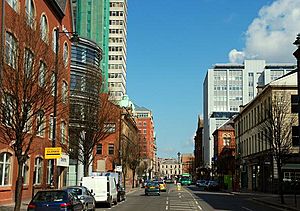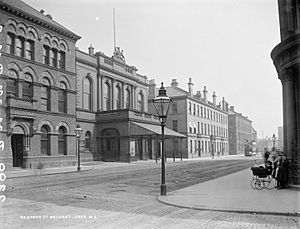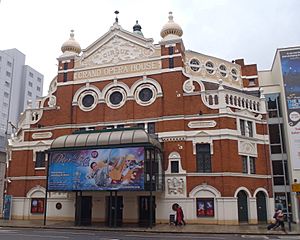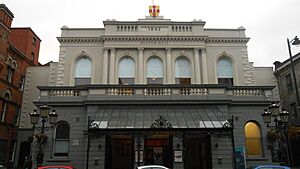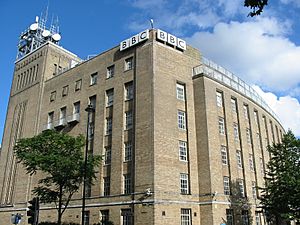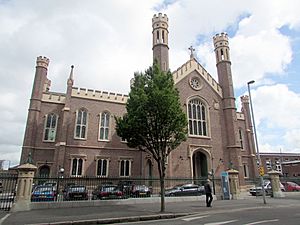Linen Quarter, Belfast facts for kids
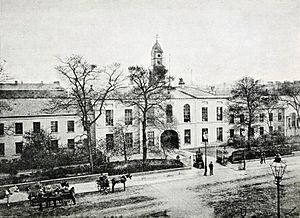
The Linen Quarter (which is An Cheathrú Linéadaigh in Irish) is a lively area in Belfast, Northern Ireland. It gets its name from the many old linen warehouses still found there. Long ago, Belfast was famous for its linen industry, and this area was at its heart.
Today, the Linen Quarter is a busy place. It has many cool places like the Ulster Hall and Grand Opera House. You'll also find lots of hotels, restaurants, cafes, and bars. It's also where Belfast's main transport hub is located. While linen isn't the main business anymore, the area is now home to modern companies. These include international consulting firms and new technology businesses. Even the Belfast City Council has offices here!
Contents
- Where is the Linen Quarter?
- Getting Around the Linen Quarter
- Amazing Buildings and Art
- Grand Opera House, Great Victoria Street
- Ulster Hall, Bedford Street
- Joseph Carey's Belfast Scenes
- Ewart's Buildings
- Broadcasting House, Ormeau Avenue
- Ormeau Baths, Ormeau Avenue
- The Thomas Thompson Memorial Fountain, Ormeau Avenue
- St Malachy’s, Alfred Street
- Monument to the Unknown Woman Worker, Great Victoria Street
- Cool Events in the Linen Quarter
- People from the Linen Quarter
Where is the Linen Quarter?
The Linen Quarter is in the city centre of Belfast. It's just south of the famous City Hall. This area is roughly shaped like a square. Its edges are Howard Street, Donegall Square South, May Street, Great Victoria Street, Ormeau Avenue, and Joy Street. However, some people now think the area is a bit bigger. It includes the Europa Transport Hub and parts of Dublin Road.
Getting Around the Linen Quarter
The Belfast Hub area has always been key for transport in the city. It connects Belfast to the rest of Ireland.
Early Railways
Belfast joined the railway age in 1839. The first train line opened from Belfast to Lisburn. A grand railway station was built on Great Victoria Street in 1848. This station became very important. It linked Belfast to Dublin, making it a major travel spot. Soon, many people were using trains to travel between Belfast and nearby towns.
Trams and Buses
Horse-drawn trams were introduced in 1872. They were a main way to get around the city. In the early 1900s, these trams became electric. This made them cheaper to use. Buses started running in 1926. At first, they helped the trams. But over time, buses replaced the trams completely. The last tram ran in 1954, and the last trolleybus in 1968.
Modern Transport Hub
In the 1960s, much of the old Great Victoria Street station was taken down. This made space for the Europa Hotel and a bus station. But in 1995, a new Great Victoria Street Station opened very close to the old site. Because this station was so successful, a new, bigger Transport Hub is being planned. It will replace both the current bus and railway stations.
Amazing Buildings and Art
The Linen Quarter is full of beautiful buildings and interesting art.
Grand Opera House, Great Victoria Street
The Grand Opera House was built in 1894-1895. It was designed by Frank Matcham, a very famous theatre designer. This theatre was made to host many different shows. These included operas, variety acts, pantomimes, and even circuses! It opened on December 16, 1895, with a pantomime called 'Blue Beard'.
Ulster Hall, Bedford Street
The Ulster Hall is a grand, two-storey building. It was finished in 1862. It was a huge source of pride for Belfast when it opened. The building showed that Belfast was growing into an important town. It also showed that people understood the need for fun and relaxation.
Joseph Carey's Belfast Scenes
In 1902, Belfast City Council asked a local artist, Joseph W. Carey, to paint thirteen scenes. These paintings show different parts of Belfast's history. They include both real events and old stories. You can see them inside the Ulster Hall. The paintings have been cleaned and fixed up twice, in 1989 and 2009.
Ewart's Buildings
This three-storey sandstone building was built in 1869. It was first for the Bedford Street Weaving Company. Later, it was bought by William Ewart and Son. They were one of the world's top linen makers. They owned mills, warehouses, and offices all over Belfast.
Broadcasting House, Ormeau Avenue
This six-storey building is home to BBC Northern Ireland. It was finished in 1939. It has a unique design with steel and different coloured bricks. Broadcasting House replaced the BBC's older offices. The BBC had been in Linenhall Street since the first local radio station started in the 1920s.
Ormeau Baths, Ormeau Avenue
This lovely Victorian building used to be public baths. It opened in the late 1880s. For many local people, it was a huge help. Their homes often didn't have bathrooms. The building had both private baths and a swimming pool. It greatly improved hygiene in the city.
The Thomas Thompson Memorial Fountain, Ormeau Avenue
This fountain is at the corner of Bedford Street and Ormeau Avenue. It faces the BBC offices. It was built to remember Thomas Thompson. He was a naval surgeon who helped fight cholera in Belfast. He also started a charity home for sick people. His daughter, Eliza, asked for the monument to be built.
St Malachy’s, Alfred Street
St Malachy's is one of Belfast's most famous and beautiful churches. It was finished in 1844. Its design is inspired by the Tudor period. The church's ceiling is very special. People often say it looks like an "upside down wedding cake." It was inspired by the Henry VII chapel in Westminster Abbey. In 2009, the church had a big restoration. This included fixing the ceiling and cleaning the stained glass windows.
Monument to the Unknown Woman Worker, Great Victoria Street
This bronze statue was made in 1992 by Louise Walsh. It is next to the Europa Hotel. The statue shows two working-class women. It includes symbols of women's work, like colanders, a shopping basket, and clothes pegs.
Cool Events in the Linen Quarter
Many interesting things have happened in the Linen Quarter over the years!
- In 1869, famous writer Charles Dickens read from his books at the Ulster Hall. He read parts of 'A Christmas Carol' and 'David Copperfield'.
- The band Led Zeppelin played their famous song Stairway to Heaven for the very first time at the Ulster Hall in 1971.
- In 1978, the National Trust bought the Crown Liquor Saloon. This happened after a public campaign to save the historic building.
People from the Linen Quarter
Many important people have connections to the Linen Quarter.
- Francis Joy (1697–1790) started Belfast's first paper mill. He also founded the Belfast News Letter in 1737. This newspaper is the oldest English-language daily newspaper still running! Joy Street is named after him.
- Andrew Mulholland (1791–1866) gave the organ to Ulster Hall in 1862. He was a key person in starting Belfast's linen industry. He opened the first large linen mill in 1830.
- Sir William Ewart (1817–1889) was a linen manufacturer. His family owned Ewart's Buildings. He was also the mayor of Belfast in 1859 and a Member of Parliament.
- Sir Otto Moses Jaffe (1846–1929) was a German-born businessman. He made his family's business, 'The Jaffe Brothers', the biggest linen exporter in Ireland. He was also the first Jewish Lord Mayor of Belfast, serving twice.
- Frank Matcham (1854–1920) was a leading theatre designer. He designed the Grand Opera House in Belfast. He designed over 90 theatres across the UK!
- Sir William Tyrone Guthrie (1900–1971) was a theatre director and broadcaster. He made BBC Northern Ireland's very first broadcast on September 15, 1924.
- Ruby Florence Murray (1935–1996) was a singer and actress from Belfast. She performed in the Ulster Hall. She became one of the UK's most popular singers in the 1950s.
- Rory Gallagher (1948–1995) was an Irish blues and rock musician. He played many times in Ulster Hall during the Troubles. This was a time when many other artists avoided playing in Northern Ireland.


